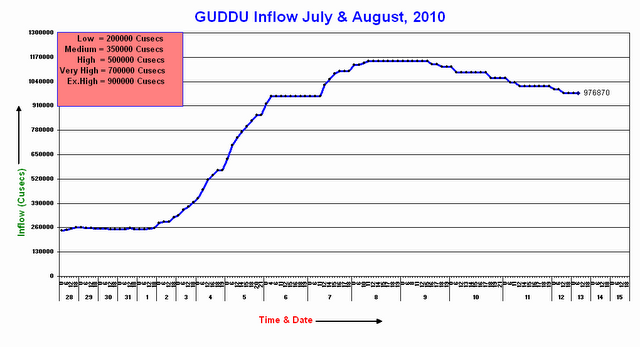13 August 2010
Update on China and Pakistan – 13th August 2010
Posted by Dave Petley
1. The Gansu landslide in China
The rescue operations in Gansu have now clearly transitioned into a recovery and rehabilitation phase, greatly hampered by continuing very heavy rainfall in the area. Landslides are continuing to occur in the area, with resultant casualties.
Tom Dijkstra of Loughborough University visited the site as part of a trip to look at collaborative landslide research in the area back in November. He has kindly sent two images of the town to me and has agreed that I can put them online. This image shows the area affected by the landslide from the other side of the river. The steep, deforested mountains in the background are clearly the source of the flow:
The second image shows the catchment source of the flow:
It is worth comparing the above image with this AP picture that I posted a few days ago of the site after the flow:
The reasons for the very high loss of life, now estimated to be 1,144 people, with a further 600 still missing, are clear given the density of buildings in the affected area.
2. Pakistan
The two flood waves in Pakistan continue to cause extreme levels of suffering. According to the FFD hydrographs the water level at Sukkur is now falling slowly after the passage of the first flood wave:
What has been particularly interesting though is that the flood level is not really increasing substantially at Kotri, the large gauging station downstream:
This presumably means one of two things. First, it could be that the water is finding another route – i.e. that it is bypassing the gauging station. Alternatively, the water is in effect trapped between the two sites, which might explain the very slow falling limb of the hydrograph. The Google Earth satellite image below shows Kotri:
It is possible that the water has flooded the adjacent land, but the news reports indicate that this is not the case, with the suggestion that the bridges downstream of Sukkur are slowing the flow down. This is dangerous in the context of the second flood wave, which at the moment remains smaller than the first. This is the hydrograph for Taunsa, which is just below the “Extremely High” flood level:
At Guddu the discharge is still falling, but only very slowly. Indeed the discharge remains well above the “Exceptionally High” level:
The danger must be that the second flood wave starts to catch up with, and build upon, the stalled first wave. This would create the potential for an extremely damaging second phase of floods. It took six days for the first wave to pass from Taunsa to Guddu, and a further day to Sukkur. The hope must be that the water level starts to fall quickly at these two sites before the second wave arrives.
Unfortunately, it is clear that this slow motion disaster has several more weeks to go, even if there is no further heavy rain.










 Dave Petley is the Vice-Chancellor of the University of Hull in the United Kingdom. His blog provides commentary and analysis of landslide events occurring worldwide, including the landslides themselves, latest research, and conferences and meetings.
Dave Petley is the Vice-Chancellor of the University of Hull in the United Kingdom. His blog provides commentary and analysis of landslide events occurring worldwide, including the landslides themselves, latest research, and conferences and meetings.
Dr. Dave,any comment on the new scientist article. Thanks.http://www.newscientist.com/article/mg20727730.101-frozen-jet-stream-links-pakistan-floods-russian-fires.html
Thanks, Dave, for ferreting out this photograph of the source of the Gansu mudslide — it makes clear (finally) why the width of the slide was so thin outside of the city. Armed with this photo, go back and look at the 3 seconds of very first helicopter video at time 1:18. (Har! I see you already have snapshot of 1:18 in your Aug 8 post. Now it makes sense.)If you slow the video down you can see the track of the constrained flow through the mountains. Notice the highwater (highmud?) marks at each turn of the gully. That suggests to me that the debris dam in the mountain was much further back in the catchment. I'll bet that it was at a significantly higher elevation than the city.
see picture # 4 at the attachedhttp://www.boston.com/bigpicture/2010/08/landslides_strike_zhouqu_count.htmlThere appears to be a smaller slide to the right